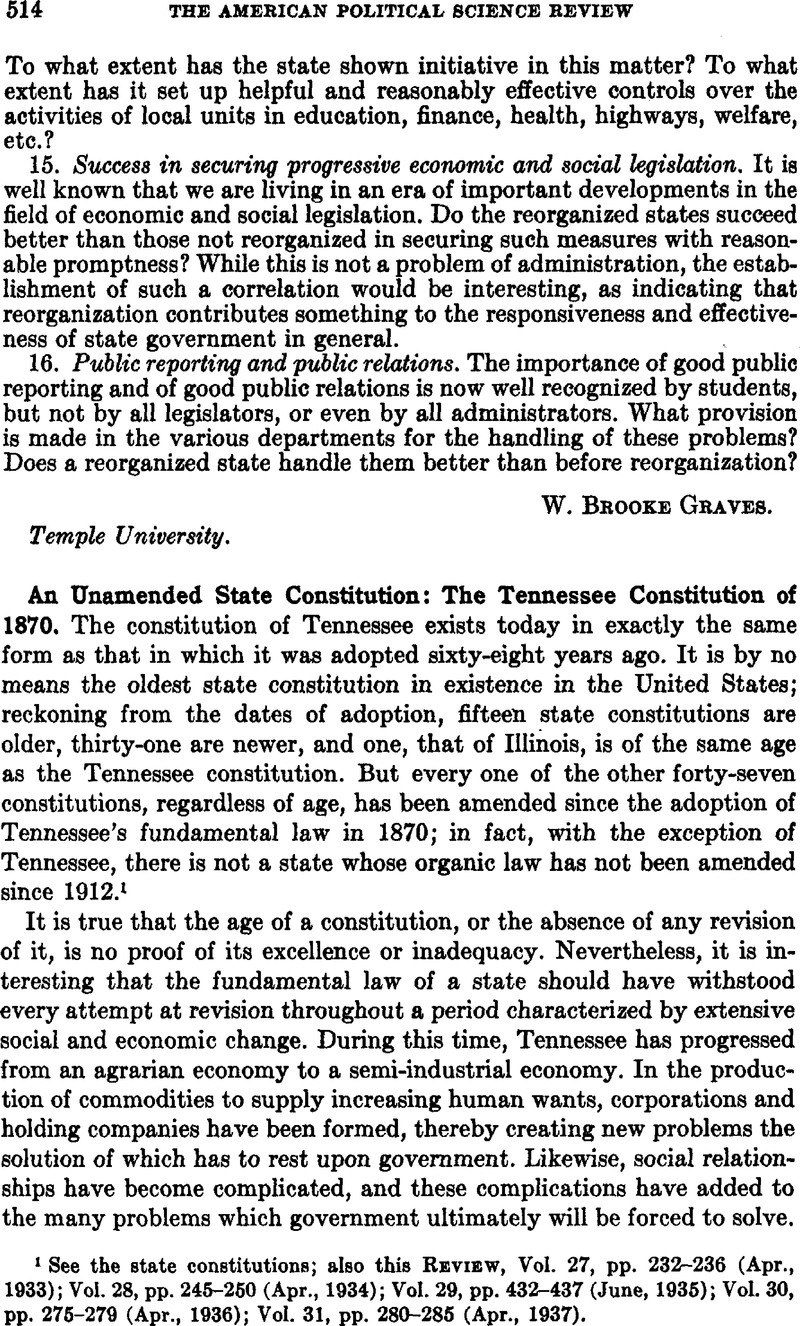No CrossRef data available.
Published online by Cambridge University Press: 02 September 2013

1 See the state constitutions; also this Review, Vol. 27, pp. 232–236 (Apr., 1933); Vol. 28, pp. 245–250 (Apr., 1934); Vol. 29, pp. 432–437 (June, 1935); Vol. 30, pp. 275–279 (Apr., 1936); Vol. 31, pp. 280–285 (Apr., 1937).
2 White, C. P. et al. , Constitutional Problems in Tennessee (Knoxville, 1937), p. 8Google Scholar.
3 Ibid., p. 114; Rohlfing, C. C., “Amendment and Revision of State Constitutions”, Annals of the American Academy of Political and Social Science, Vol. 181, pp. 180–181 (Sept., 1935)CrossRefGoogle Scholar.
4 Caldwell, Joshua W., Studies in the Constitutional History of Tennessee (2nd ed., Cincinnati, 1907), pp. 189–190, 296–305Google Scholar.
5 The votes in Tables I, II, and III on the proposals in the legislature have been compiled from the Tennessee Senate and House Journals, 1870–1935, and they are the votes on third reading. The popular votes in Tables I and II have been compiled from the election books in the office of the secretary of state, Nashville. These election returns are incomplete. So far as could be determined, the Nashville and Knoxville newspapers did not carry the complete results of any elections. The question of calling a convention can be submitted to the people at any time by a majority of all the members elected to each house of the legislature.
6 Proceedings of the Tennessee Bar Association (Nashville, 1936), pp. 46–47Google Scholar.
7 Acts of Tennessee, 1896, ch. 1.
8 Acts of Tennessee, 1897, ch. 11; Senate Journal, 1897, p. 467Google Scholar.
9 Senate Journal, 1913, pp. 910–911Google Scholar.
10 Public Acts of Tennessee, 1935, ch. 127.
11 Public Acts of Tennessee, First Extraordinary Session, 1935, p. 857Google Scholar.
12 Proceedings of the Tennessee Bar Association, 1917, p. 82Google Scholar; Knoxville Journal and Tribune, July 29, 1917.
13 For the two views on the validity of a limited convention, see Witham, H. B., “On Amending the Constitution of Tennessee”, Tennessee Law Review, Vol. 11, pp. 178–180 (Apr., 1933)Google Scholar, and O. T. Tindell, “The Validity of the Act of 1925 Calling a Constitutional Convention in Tennessee, ibid., Vol. 4, p. 203 (May, 1926). The nine proposals were as follows: (1) a classified property tax, (2) limitation of legislative enactments to public issues, (3) increase in membership of the supreme court, and investment of the court with the power to give advisory opinions, (4) increase in the per diem of legislators and a decrease in their number, (5) easier amendment process, (6) authorization of legislature to pass laws to induce a more general exercise of the franchise, (7) extension of term of office for governor with an in eligibility provision, and extension of terms of other officials where legislature deemed it advisable, (8) adoption of an official code, (9) authorization of legislature to abolish the fee system where deemed necessary. In 1931, action of the proposed convention was to be restricted to four issues as follows: (1) a classified property tax, (2) consideration of local affairs by local bodies, (3) increase in per diem for legislators, (4) extension of the term of office for governor.
14 The constitution provides that amendments shall be ratified by a majority of all the citizens of the state voting for representatives. The vote on the amendments should, therefore, be compared with the total vote on representatives if the best results are to be obtained. It was possible to determine the total vote for representatives in only a few instances; hence the vote for governor was used, and it has been found that the latter vote does not differ greatly from that for representatives.
16 Knoxville Journal and Tribune, Oct. 31, 1922.
17 Senate Journal, 1927, pp. 118–119Google Scholar.
18 In 1937, amendments were passed by the legislature providing for an increase in the term and compensation of the governor, an income tax, and a lieutenantgovernor. These are awaiting action by the second legislature, which will convene in 1939. Information is not available on the vote on these proposals in the legislature, nor on the vote on the proposition which carried over from 1935.
19 Caldwell, op. cit., pp. 327–328.
20 McWhorter, J. L., Just for Tennessee (Nashville, 1917), p. 1Google Scholar.
21 House Journal, 1887, p. 153Google Scholar; Public Acts of Tennessee, 1917, pp. 586–586Google Scholar; ibid., 1925, Senate Joint Resolution No. 32.
21 Knoxville News-Sentinel, Sept. 24, 1931; Nashville Tennetsean, Sept. 27, 1931.
22 Senate Journal, 1927, pp. 342–344Google Scholar.
23 Acklen, Joseph H., Subjects for Consideration (State Central Committee on Constitutional Convention, Nashville, 1919), p. 22Google Scholar.
Comments
No Comments have been published for this article.